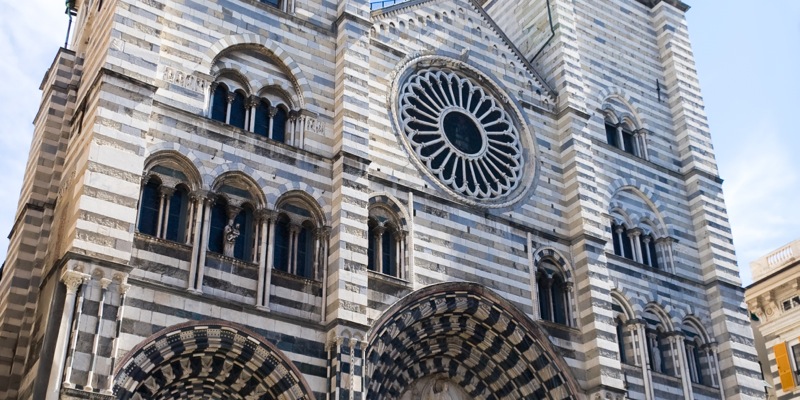San Lorenzo has been the city’s cathedral since the 10th century, but owes its present-day aspect to artists from Pisa, Lombardy, France and Normandy who worked at it between the 12th and the 17th century, merging the Romanesque and Gothic styles. Gothic re-construction works stopped quite suddenly, however, perhaps for reasons of economic hardship or perhaps because of the black plague of 1300, leaving the building incomplete without one of the two originally designed bell towers. At the front on the façade, visitors are welcomed by two mournful-looking 19th-century lions. The martyrdom of Saint Lawrence is represented in the lunette above the main doorway and a little above that, is the image of God the Father surrounded by the symbols of the four Evangelists. Inside the white marble panels at the basis of the embrasures of the doorways are images of animals taken from ancient ‘bestiaries’ (illustrated volumes containing the description of animals and birds), ideally intending to highlight the contrast between good (at the top) and evil (at the bottom). On the right hand corner of the façade visitors will see the statue of the Knife-grinder, but actually representing Saint John the Evangelist holding a sun-dial. A little further on is the statue of a small dog sleeping at the foot of a column, portrayed by one of the artists who decorated the façade. This image is thought to bring luck to visitors who grace the statue with a friendly stroke. On the inside, the mid-15th-century Chapel of Saint John the Baptist (Cappella di San Giovanni Battista) is particularly interesting due to its rich relief decorations of the Stories of Saint John, of scenes from the lives of the Saints, of images of the Virtues and of the Fathers of the Church. Decorated in the 16th and 17th centuries by artists such as Giovanni A. Montorsoli, an assistant to Michelangelo, who worked on the statues, and Lazzaro Tavarone who worked on the frescoes, the apse is surmounted by an elegant Mannerist-style dome by architect Galeazzo Alessi. There are many different treasures held inside the underground Museum of the Treasure of San Lorenzo (Museo del Tesoro), such as the 15th century silver-gilded ark of Saint John the Baptist, whose ashes were brought here from the Holy Land during the crusades. Among the treasury are masterpieces of gold- and silverware dating between the 9th century and the present. Famous exhibits of this museum are the Byzantine Zaccaria Cross and the Holy Dish (Sacro Catino), possibly a piece of green Islamic glassware from the 9th century said to have been used by Jesus at the Last Supper. At the back of the left aisle stands a miraculously unexploded British Navy bomb that hit the cathedral when Genoa was bombed in February 1941. Visitors should not miss seeing the 12th-century cloister (the entrance is quite close to the church) where the Diocesan Museum is housed.
Are you a local? What do you think about Cathedral of St. Lawrence?
Login to suggest it!


